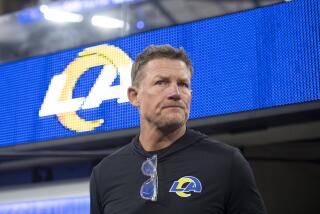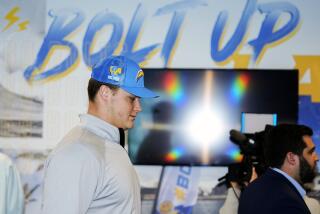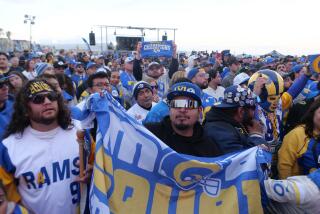HIT AND MISS : Sometimes, the Big Names Were the Last Names Taken in the Draft
The year was 1977. The NFL draft was winding to a close. At the central command post of the then-Oakland Raiders, a lot of head scratching was going on.
The Raiders had one last pick, the 317th of the draft. But who? Close your eyes and stick a pin in a list of names? Go for the meanest looking guy? Grab a phone book?
Coach John Madden had a better idea.
He called his boyhood friend, USC Coach John Robinson.
“Is there anybody we should be talking to?” Madden asked. “You guys have to have second stringers who are better than some of the guys left.”
Responded Robinson, “Has Rod Martin been taken? I’m sure he can play in the NFL.”
He could, he did and he still is playing. Martin has played linebacker for the Raiders for 13 years, twice making the Pro Bowl.
Madden had tripped over another diamond in the rough. So much for the science of drafting, for the scouts and the performance charts and the stopwatches and the physicals.
Sometimes you get lucky. It happens. Not that often. Not nearly as much as it used to, but it happens. Some of the biggest names in pro football history were some of the last names taken in the draft.
Raymond Berry, perhaps the premier receiver of his day for the Baltimore Colts, lasted until the 20th round in 1954 after a career at SMU.
And what about his partner in one of football’s all-time passing combinations, quarterback John Unitas? He was drafted in the ninth round by the Pittsburgh Steelers out of Louisville in 1955, was cut and wound up playing for the Bloomfield Rams, a Pittsburgh area semipro team, for $6 a game. It was there that the Colts found him.
So within the span of two years, the Colts took a sandlot player and a 20th-round pick who formed the backbone of a championship team.
There are many such success stories in the NFL and here are just some of them, with apologies to those we’ve left out:
--Bart Starr, Green Bay Packer quarterback during the dynasty years of the 60s, was a 17th-round from Alabama in 1956.
--Deacon Jones, a pillar of the Rams’ Fearsome Foursome defensive line, was a 14th-round selection from South Carolina State in 1961. That same year, the Rams found offensive lineman Charlie Cowan of New Mexico Highlands in the 21st round and he went on to play for them for 15 seasons.
--The Rams drafted lineman Larry Brooks, who played for them for a decade, from Virginia State in the 14th round in 1972.
--Drew Hill of Georgia Tech, now a star receiver for the Houston Oilers, was a last-round pick in 1979, the 328th man selected. The Rams drafted Hill, then traded him to Houston.
--Karl Mecklenburg, the linebacker who anchors the Denver Broncos’ defense, was a final-round pick from Minnesota in 1983.
--Roosevelt Brown, lineman from Morgan State, was drafted in the 27th round in 1953 by the New York Giants, for whom he played 13 seasons.
--Don Nottingham of Kent State was the last guy taken in the entire 1971 draft, yet he became an excellent short-yardage ballcarrier for Baltimore, earning the nickname the Human Bowling Ball.
--A lot of clubs said thanks, but no thanks to Roger Staubach, the Heisman Trophy winning quarterback from Navy, but a man with a long-term service commitment upon graduation. Set at quarterback with Don Meredith, the Cowboys figured he was worth the wait. So in 1964, they picked Staubach in the 10th round. Four Super Bowls later, who can argue?
--The Raiders were looking at several receivers at San Jose State. Mervyn Fernandez was not one of them, but when they saw what he could do, they took a chance, drafting him in the 10th round in 1983, although he was destined for the Canadian Football League. Five years later, though, Fernandez is wearing silver and black.
--And just three years ago, the Raiders took a shot in the seventh round, grabbing Heisman Trophy-winning running back Bo Jackson of Auburn, even though he had insisted that his future was in baseball.
One of the most predictable cliches in the draft, any draft, any sport, comes out of the mouths of coaches and general managers with increasing frequency as the day wears on.
“We just couldn’t believe (fill in the name) would still be available,” they’ll say. “This is the guy we wanted all along.”
The inference is that their guy is going to be a lot faster, a lot stronger, a lot better than anybody dreamed.
These days, it is the club official who think he’s going to find some unknown phenom who is the dreamer. If you’ll notice, few of the above success stories happened in recent years.
“It’s really hard to find diamonds in the rough now,” said Dick Steinberg, director of player development for the New England Patriots.
“Now that the draft is held in April, everybody has time to catch up. Back when the draft was held in January, or even November, those teams that really worked at evaluating players were rewarded. Now, if there’s a guy you heard about in the fall, you have a chance to get your coaches caught up.
“It was really the Rams who started it all in the ‘50s, extensively scouting players. Dallas seemed to have a bigger group than anybody else scouting and more information in the ‘60s. The Raiders have always done a good job because they do a lot of scratching around, a lot of mailings, dealing with high schools.”
Another difference is the sheer numbers.
“We draft 12 rounds now,” said Raider official Al LoCasale. “We used to draft 17 rounds, down to the guys who are free agents today. You are drafting 140 fewer people.”
Now, all but three clubs--the Raiders, Broncos and San Francisco 49ers--belong to scouting combines that share information, further limiting the potential for finding unheralded stars on your own. And in February, the top 350 college stars are invited to a camp where everybody is thoroughly examined by football people and doctors alike.
Steinberg said: “The way it is now, in the later rounds, you don’t have somebody drafted where everybody on the other clubs will pop up and say, ‘Who the hell is he?’ You bring in 350 guys, you pretty much take care of everybody.”
All this has worked against a club like the Raiders, operating outside the combine.
“When the draft was in November, December, January, there was not as much time for evaluation camps,” LoCasale said. “You had just completed your season and you were in the draft. That could be a real plus for clubs like ours. Now, with the extra three to four months to bring in players for physicals and work them out, it works to the disadvantage of teams like the Raiders and Dallas.
“In the old days, there was a lot of rumor to live with. Such and such might have started a rumor to try and stash a guy. With the camp in Indianapolis, though, you’re dealing with more fact than conjecture. Everybody is screened.”
It may be a new game now, but, LoCasale says, the Raiders will continue to play with their own ball.
“We are not in the scouting pool because we have guys that we have a lot of faith in,” he said. “There may be 28 scouts who have seen a player and 27 who liked him. The other one will bite his tongue and go along, figuring, if they are wrong, they’ll all be wrong. Our guys say what they think.”
Although a member of the scouting combine, the Cowboys are another organization averse to the herd mentality.
“We found a lot of bargains in the small colleges,” said Dallas’ Gil Brandt, a pioneer in ferreting out hidden talent. “We found Rayfield Wright at Ft. Valley State, Cliff Harris at Ouachita, Pettis Norman at J. C. Smith, and Jethro Pugh at Elizabeth City State.
“We entered the league without a draft choice. At the end of the first year, Tex (Schramm, general manager), Tom (Landry, coach) and I sat down and planned how we were going to be competitive. Tex allocated the money we needed for scouting. We had Dick Mansperger in charge of just the small black schools.”
Said Joel Buchsbaum of Pro Football Weekly: “When the Cowboys drafted Pugh and Wright, half the clubs in the league didn’t even know who they were. Everybody has the same information now. It’s just a matter of seeing how they fit in to your club. There are very few sleepers anymore.”
Brandt figures even his own methods are no longer operable.
“We really did well at the small schools,” he said. “But I think the small schools are no longer as productive as they once were because the UCLAs and the Iowas do a much better job of recruiting. They no longer just take players recommended by their barbers or their friends.
“Then too, with integration, black players have gone to schools all over the country. A black player from North Carolina might go to a Minnesota. And with the scouting combines today, if there’s a player at, say, Helena, Mont., everybody knows him.”
That’s not to say all the fun has gone out of the draft.
“It’s one thing to like a guy and another to know what round to spend a pick on,” Steinberg said. “That’s the secret to putting a draft together. If you wait a round on a guy, you may wait too long.”
Besides, insisted Buchsbaum, it will always be a guessing game to some extent.
“Because you’re dealing with human beings, you can never be sure,” he said. “Anytime you’re dealing with the human element, that is the case. You might have a doctor rejected by all the medical schools. But he’ll go outside the country and become great. Or you have a guy go to Harvard and become a lousy doctor. You can’t predict human behavior to that degree.
“Larry Brooks was someone everybody knew about. But he had the all-time bad body ever seen in college. Boy, was he out of shape! Once he got into shape, he became a hell of a player.”
Even when you make the right choice, you can’t be sure. In 1970, the Raiders made tight end Raymond Chester their top pick.
Madden then got a call from another coach who told him, “We’ve got 300 names on a board here and Chester is not one of them. Who is this guy?”
In 1965, the Cowboys and the San Diego Chargers, then in separate leagues, were going head to head over an Arizona State running back named Gene Foster.
The Cowboys finally dropped out and Foster went on to play six years for the Chargers.
A Cowboy official later told Sid Gillman, then the Charger coach, that Dallas had dropped out because the club’s sophisticated computer system had indicated Foster wouldn’t have much of a chance of making it.
“On third and three, I give the ball to Foster and he gets me a first down,” Gillman replied. “What can that . . . computer do for you?”
More to Read
Go beyond the scoreboard
Get the latest on L.A.'s teams in the daily Sports Report newsletter.
You may occasionally receive promotional content from the Los Angeles Times.










